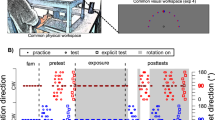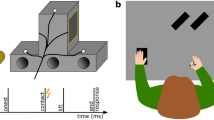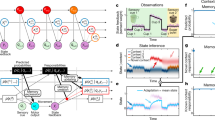Abstract
Skilful object manipulation requires learning the dynamics of objects, linking applied force to motion1,2. This involves the formation of a motor memory3,4, which has been assumed to be associated with the object, independent of the point on the object that one chooses to control. Importantly, in manipulation tasks, different control points on an object, such as the rim of a cup when drinking or its base when setting it down, can be associated with distinct dynamics. Here, we show that opposing dynamic perturbations, which interfere when controlling a single location on an object, can be learned when each is associated with a separate control point. This demonstrates that motor memory formation is linked to control points on the object, rather than the object per se. We also show that the motor system only generates separate memories for different control points if they are linked to different dynamics, allowing efficient use of motor memory. To account for these results, we develop a normative switching state-space model of motor learning, in which the association between cues (control points) and contexts (dynamics) is learned rather than fixed. Our findings uncover an important mechanism through which the motor system generates flexible and dexterous behaviour.
This is a preview of subscription content, access via your institution
Access options
Access Nature and 54 other Nature Portfolio journals
Get Nature+, our best-value online-access subscription
$29.99 / 30 days
cancel any time
Subscribe to this journal
Receive 12 digital issues and online access to articles
$119.00 per year
only $9.92 per issue
Buy this article
- Purchase on Springer Link
- Instant access to full article PDF
Prices may be subject to local taxes which are calculated during checkout




Similar content being viewed by others
References
Shadmehr, R., Smith, M. A. & Krakauer, J. W. Error correction, sensory prediction, and adaptation in motor control. Annu. Rev. Neurosci. 33, 89–108 (2010).
Wolpert, D. M., Diedrichsen, J. & Flanagan, J. R. Principles of sensorimotor learning. Nat. Rev. Neurosci. 12, 739–751 (2011).
Johansson, R. S. & Westling, G. Roles of glabrous skin receptors and sensorimotor memory in automatic control of precision grip when lifting rougher or more slippery objects. Exp. Brain Res. 56, 550–564 (1984).
Johansson, R. S. & Flanagan, J. R. Coding and use of tactile signals from the fingertips in object manipulation tasks. Nat. Rev. Neurosci. 10, 345–359 (2009).
Ingram, J. N. & Wolpert, D. M. Naturalistic approaches to sensorimotor control. Prog. Brain Res. 191, 3–29 (2011).
Westling, G. & Johansson, R. S. Factors influencing the force control during precision grip. Exp. Brain Res. 53, 277–284 (1984).
Johansson, R. S. & Westling, G. Coordinated isometric muscle commands adequately and erroneously programmed for the weight during lifting task with precision grip. Exp. Brain Res. 71, 59–71 (1988).
Gordon, A. M., Westling, G., Cole, K. J. & Johansson, R. S. Memory representations underlying motor commands used during manipulation of common and novel objects. J. Neurophysiol. 69, 1789–1796 (1993).
Flanagan, J. R. & Beltzner, M. A. Independence of perceptual and sensorimotor predictions in the size–weight illusion. Nat. Neurosci. 3, 737–741 (2000).
Baugh, L. A., Kao, M., Johansson, R. S. & Flanagan, J. R. Material evidence: interaction of well-learned priors and sensorimotor memory when lifting objects. J. Neurophysiol. 108, 1262–1269 (2012).
Flanagan, J. R., Bowman, M. C. & Johansson, R. S. Control strategies in object manipulation tasks. Curr. Opin. Neurobiol. 16, 650–659 (2006).
Fu, Q. & Santello, M. Context-dependent learning interferes with visuomotor transformations for manipulation planning. J. Neurosci. 32, 15086–15092 (2012).
Fu, Q. & Santello, M. Retention and interference of learned dexterous manipulation: interaction between multiple sensorimotor processes. J. Neurophysiol. 113, 144–155 (2015).
Wolpert, D. M. & Flanagan, J. R. Q&A: robotics as a tool to understand the brain. BMC Biol. 8, 92 (2010).
Shadmehr, R. & Mussa-Ivaldi, F. A. Adaptive representation of dynamics during learning of a motor task. J. Neurosci. 14, 3208–3224 (1994).
Dingwell, J. B., Mah, C. D. & Mussa-Ivaldi, F. A. Manipulating objects with internal degrees of freedom: evidence for model-based control. J. Neurophysiol. 88, 222–235 (2002).
Dingwell, J. B., Mah, C. D. & Mussa-Ivaldi, F. A. Experimentally confirmed mathematical model for human control of a non-rigid object. J. Neurophysiol. 91, 1158–1170 (2004).
Nagengast, A. J., Braun, D. A. & Wolpert, D. M. Optimal control predicts human performance on objects with internal degrees of freedom. PLoS Comput. Biol. 5, e1000419 (2009).
Nasseroleslami, B., Hasson, C. J. & Sternad, D. Rhythmic manipulation of objects with complex dynamics: predictability over chaos. PLoS Comput. Biol. 10, e1003900 (2014).
Flanagan, J. R. & Wing, A. M. The role of internal models in motion planning and control: evidence from grip force adjustments during movements of hand-held loads. J. Neurosci. 17, 1519–1528 (1997).
Ahmed, A. A., Wolpert, D. M. & Flanagan, J. R. Flexible representations of dynamics are used in object manipulation. Curr. Biol. 18, 763–768 (2008).
Danion, F., Diamond, J. S. & Flanagan, J. R. The role of haptic feedback when manipulating nonrigid objects. J. Neurophysiol. 107, 433–441 (2012).
Sheahan, H. R., Franklin, D. W. & Wolpert, D. M. Motor planning, not execution, separates motor memories. Neuron 92, 773–779 (2016).
Smith, M. A., Ghazizadeh, A. & Shadmehr, R. Interacting adaptive processes with different timescales underlie short-term motor learning. PLoS Biol. 4, e179 (2006).
Scheidt, R. A., Reinkensmeyer, D. J., Colborn, M. A., Rymer, W. Z. & Mussa-Ivaldi, F. A. Persistence of motor adaptation during constrained, multi-joint, arm movements. J. Neurophysiol. 84, 853–862 (2000).
Cothros, N., Wong, J. D. & Gribble, P. L. Are there distinct neural representations of object and limb dynamics? Exp. Brain Res. 173, 689–697 (2006).
Kluzik, J., Diedrichsen, J., Shadmehr, R. & Bastian, A. J. Reach adaptation: what determines whether we learn an internal model of the tool or adapt the model of our arm? J. Neurophysiol. 100, 1455–1464 (2008).
Gandolfo, F., Mussa-Ivaldi, F. A. & Bizzi, E. Motor learning by field approximation. Proc. Natl Acad. Sci. USA 93, 3843–3846 (1996).
Howard, I. S., Wolpert, D. M. & Franklin, D. W. The effect of contextual cues on the encoding of motor memories. J. Neurophysiol. 109, 2632–2644 (2013).
Salimi, I., Hollender, I., Frazier, W. & Gordon, A. M. Specificity of internal representations underlying grasping. J. Neurophysiol. 84, 2390–2397 (2000).
Bursztyn, L. L. & Flanagan, J. R. Sensorimotor memory of weight asymmetry in object manipulation. Exp. Brain Res. 184, 127–133 (2008).
Ingram, J. N., Howard, I. S., Flanagan, J. R. & Wolpert, D. M. Multiple grasp-specific representations of tool dynamics mediate skillful manipulation. Curr. Biol. 20, 618–623 (2010).
Ingram, J. N., Howard, I. S., Flanagan, J. R. & Wolpert, D. M. A single-rate context-dependent learning process underlies rapid adaptation to familiar object dynamics. PLoS Comput. Biol. 7, e1002196 (2011).
Ingram, J. N., Flanagan, J. R. & Wolpert, D. M. Context-dependent decay of motor memories during skill acquisition. Curr. Biol. 23, 1107–1112 (2013).
Milner, T. E. & Franklin, D. W. Impedance control and internal model use during the initial stage of adaptation to novel dynamics in humans. J. Physiol. 567, 651–664 (2005).
Howard, I. S., Ingram, J. N., Franklin, D. W. & Wolpert, D. M. Gone in 0.6 seconds: the encoding of motor memories depends on recent sensorimotor states. J. Neurosci. 32, 12756–12768 (2012).
Berniker, M., Franklin, D. W., Flanagan, J. R., Wolpert, D. M. & Kording, K. Motor learning of novel dynamics is not represented in a single global coordinate system: evaluation of mixed coordinate representations and local learning. J. Neurophysiol. 111, 1165–1182 (2014).
Nozaki, D. & Scott, S. H. Multi-compartment model can explain partial transfer of learning within the same limb between unimanual and bimanual reaching. Exp. Brain Res. 194, 451–463 (2009).
Lee, J. Y. & Schweighofer, N. Dual adaptation supports a parallel architecture of motor memory. J. Neurosci. 29, 10396–10404 (2009).
Kim, S., Oh, Y. & Schweighofer, N. Between-trial forgetting due to interference and time in motor adaptation. PLoS ONE 10, e0142963 (2015).
Thoroughman, K. A. & Shadmehr, R. Learning of action through adaptive combination of motor primitives. Nature 407, 742–747 (2000).
Trewartha, K. M., Garcia, A., Wolpert, D. M. & Flanagan, J. R. Fast but fleeting: adaptive motor learning processes associated with aging and cognitive decline. J. Neurosci. 34, 13411–13421 (2014).
Ackerson, G. & Fu, K. On state estimation in switching environments. IEEE Trans. Autom. Contr. 15, 10–17 (1970).
Chang, C. B. & Athans, M. State estimation for discrete systems with switching parameters. IEEE Trans. Aerosp. Electron. Syst. 14, 418–425 (1978).
Shumway, R. H. & Stoffer, D. S. Dynamic linear models with switching. J. Am. Stat. Assoc. 86, 763–769 (1991).
Howard, I. S., Wolpert, D. M. & Franklin, D. W. The value of the follow-through derives from motor learning depending on future actions. Curr. Biol. 25, 397–401 (2015).
Nozaki, D., Kurtzer, I. & Scott, S. H. Limited transfer of learning between unimanual and bimanual skills within the same limb. Nat. Neurosci. 9, 1364–1366 (2006).
Yokoi, A., Hirashima, M. & Nozaki, D. Gain field encoding of the kinematics of both arms in the internal model enables flexible bimanual action. J. Neurosci. 31, 17058–17068 (2011).
Richter, S., Jansen-Osmann, P., Konczak, J. & Kalveram, K.-T. Motor adaptation to different dynamic environments is facilitated by indicative context stimuli. Psychol. Res. 68, 245–251 (2004).
Yeo, S.-H., Wolpert, D. M. & Franklin, D. W. Coordinate representations for interference reduction in motor learning. PLoS ONE 10, e0129388 (2015).
Hwang, E. J., Smith, M. A. & Shadmehr, R. Dissociable effects of the implicit and explicit memory systems on learning control of reaching. Exp. Brain Res. 173, 425–437 (2006).
Hirashima, M. & Nozaki, D. Distinct motor plans form and retrieve distinct motor memories for physically identical movements. Curr. Biol. 22, 432–436 (2012).
Chib, V. S., Krutky, M. A., Lynch, K. M. & Mussa-Ivaldi, F. A. The separate neural control of hand movements and contact forces. J. Neurosci. 29, 3939–3947 (2009).
Casadio, M., Pressman, A. & Mussa-Ivaldi, F. A. Learning to push and learning to move: the adaptive control of contact forces. Front. Comput. Neurosci. 9, 118 (2015).
Iriki, A., Tanaka, M. & Iwamura, Y. Coding of modified body schema during tool use by macaque postcentral neurones. Neuroreport 7, 2325–2330 (1996).
Yamamoto, S. & Kitazawa, S. Sensation at the tips of invisible tools. Nat. Neurosci. 4, 979–980 (2001).
Farnè, A., Iriki, A. & Làdavas, E. Shaping multisensory action–space with tools: evidence from patients with cross-modal extinction. Neuropsychologia 43, 238–248 (2005).
Witt, J. K., Proffitt, D. R. & Epstein, W. Tool use affects perceived distance, but only when you intend to use it. J. Exp. Psychol. Hum. Percept. Perform. 31, 880–888 (2005).
Haggard, P. W. & Wolpert, D. M. in Higher-Order Motor Disorders Ch. 14 (Oxford Univ. Press, Oxford, 2004).
Benton, A. L. Right–Left Discrimination and Finger Localization: Development and Pathology (Hoeber-Harper, New York, NY, 1959).
Jacobs, R. A., Jordan, M. I., Nowlan, S. J. & Hinton, G. E. Adaptive mixtures of local experts. Neural Comput. 3, 79–87 (1991).
Wolpert, D. M. & Kawato, M. Multiple paired forward and inverse models for motor control. Neural Netw. 11, 1317–1329 (1998).
Ghahramani, Z. & Hinton, G. E. Variational learning for switching state-space models. Neural Comput. 12, 831–864 (2000).
Baddeley, R. J., Ingram, H. A. & Miall, R. C. System identification applied to a visuomotor task: near-optimal human performance in a noisy changing task. J. Neurosci. 23, 3066–3075 (2003).
Burge, J., Ernst, M. O. & Banks, M. S. The statistical determinants of adaptation rate in human reaching. J. Vis. 8, 20.1–20.19 (2008).
Zarahn, E., Weston, G. D., Liang, J., Mazzoni, P. & Krakauer, J. W. Explaining savings for visuomotor adaptation: linear time-invariant state-space models are not sufficient. J. Neurophysiol. 100, 2537–2548 (2008).
Huang, V. S. & Shadmehr, R. Persistence of motor memories reflects statistics of the learning event. J. Neurophysiol. 102, 931–940 (2009).
Fox, E., Sudderth, E. B., Jordan, M. I. & Willsky, A. S. in Advances in Neural Information Processing Systems 21 (eds Koller, D., Schuurmans, D., Bengio, Y. & Bottou, L.) 457–464 (Curran Associates, Red Hook, NY, 2009).
Oldfield, R. C. The assessment and analysis of handedness: the Edinburgh inventory. Neuropsychologia 9, 97–113 (1971).
Howard, I. S., Ingram, J. N. & Wolpert, D. M. A modular planar robotic manipulandum with end-point torque control. J. Neurosci. Methods 181, 199–211 (2009).
Ingram, J. N., Sadeghi, M., Flanagan, J. R. & Wolpert, D. M. An error-tuned model for sensorimotor learning. PLoS Comput. Biol. 13, e1005883 (2017).
Land, M. F. & Furneaux, S. The knowledge base of the oculomotor system. Philos. Trans. R. Soc. Lond. B Biol. Sci. 352, 1231–1239 (1997).
Johansson, R. S., Westling, G., Backstrom, A. & Flanagan, J. R. Eye–hand coordination in object manipulation. J. Neurosci. 21, 6917–6932 (2001).
Land, M. F., Mennie, N. & Rusted, J. Eye movements and the roles of vision in activities of daily living: making a cup of tea. Perception 28, 1311–1328 (1999).
Doucet, A., Gordon, N. J. & Kroshnamurthy, V. Particle filters for state estimation of jump Markov linear systems. IEEE Trans. Signal Process. 49, 613–624 (2001).
Bar-Shalom, Y., Rong Li, X. & Kirubarajan, T. Estimation with Applications to Tracking and Navigation (John Wiley & Sons, New York, NY, 2001).
Dempster, A. P., Laird, N. M. & Rubin, D. B. Maximum likelihood from incomplete data via the EM algorithm. J. R. Stat. Soc. Ser. B Stat. Methodol. 39, 1–38 (1977).
Cappé, O. & Moulines E. On‐line expectation-maximization algorithm for latent data models. J. R. Stat. Soc. 71, 593–613 (2009).
Cappé, O. Online EM algorithm for hidden Markov models. J. Comput. Graph. Stat. 20, 728–749 (2011).
George, A. P. & Powell, W. B. Adaptive stepsizes for recursive estimation with applications in approximate dynamic programming. Mach. Learn. 65, 167–198 (2006).
Robbins, H. & Monro, S. A stochastic approximation method. Ann. Math. Stat. 22, 400–407 (1951).
Del Moral, P., Doucet, A. & Singh, S. Forward smoothing using sequential Monte Carlo. Preprint at https://arxiv.org/abs/1012.5390 (2010).
Özkan, E., Lindsten, F., Fritsche, C. & Gustafsson, F. Recursive maximum likelihood identification of jump Markov nonlinear systems. IEEE Trans. Signal Process. 63, 754–765 (2015).
Kalman, R. E. A new approach to linear filtering and prediction problems. J. Basic Eng. 82, 35–45 (1960).
Kass, R. E. & Raftery, A. E. Bayes factors. J. Am. Stat. Assoc. 90, 773–795 (1995).
Jeffreys, H. The Theory of Probability (Oxford Univ. Press, Oxford, 1998).
Acknowledgements
We thank G. Žalalytė and A. Pantelides for assistance with the experiments, and S. Singh for advice on the model. We thank the Wellcome Trust, Royal Society (Noreen Murray Professorship in Neurobiology to D.M.W.), Engineering and Physical Sciences Research Council and Canadian Institutes of Health Research for support. The funders had no role in the study design, data collection and analysis, decision to publish or preparation of the manuscript.
Author information
Authors and Affiliations
Contributions
All authors conceived and designed the experiments. J.B.H. performed the experiments, and developed and fit the SSSM. All authors wrote the paper, discussed the results and edited the manuscript.
Corresponding author
Ethics declarations
Competing interests
The authors declare no competing interests.
Additional information
Publisher’s note: Springer Nature remains neutral with regard to jurisdictional claims in published maps and institutional affiliations.
Supplementary information
Supplementary Information
Supplementary Figures, Supplementary Tables and Supplementary References
Rights and permissions
About this article
Cite this article
Heald, J.B., Ingram, J.N., Flanagan, J.R. et al. Multiple motor memories are learned to control different points on a tool. Nat Hum Behav 2, 300–311 (2018). https://doi.org/10.1038/s41562-018-0324-5
Received:
Accepted:
Published:
Issue Date:
DOI: https://doi.org/10.1038/s41562-018-0324-5
This article is cited by
-
Game theory and partner representation in joint action: toward a computational theory of joint agency
Phenomenology and the Cognitive Sciences (2022)
-
Contextual inference underlies the learning of sensorimotor repertoires
Nature (2021)
-
Transfer and generalization of learned manipulation between unimanual and bimanual tasks
Scientific Reports (2021)
-
How different effectors and action effects modulate the formation of separate motor memories
Scientific Reports (2019)
-
The visual geometry of a tool modulates generalization during adaptation
Scientific Reports (2019)



